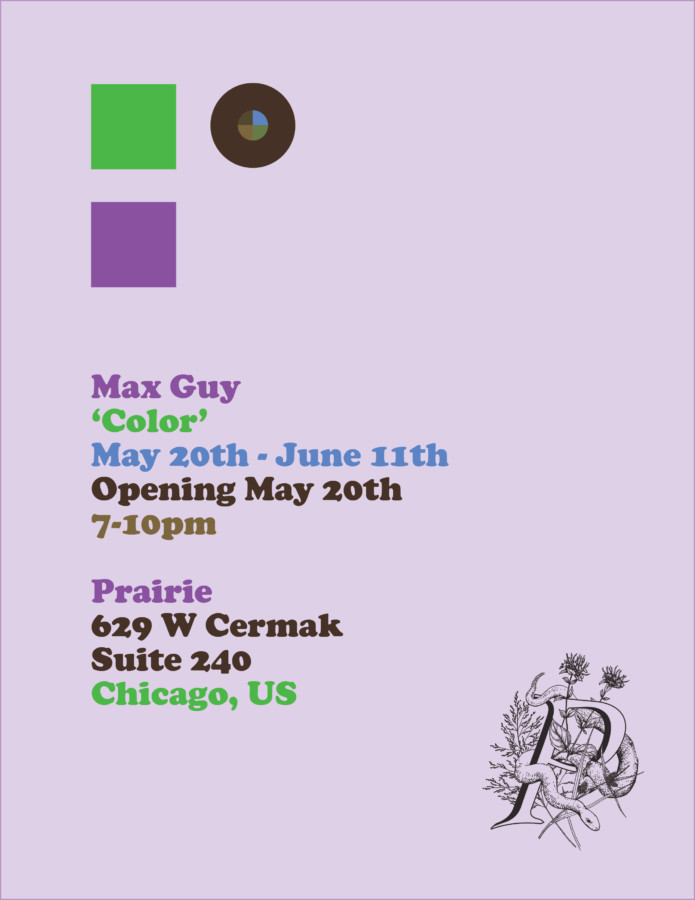Max Guy: Color
@ Prairie
629 W Cermak Rd, Suite 240, Chicago IL 60608
Opening Saturday, May 20th, from 7PM - 10PM
On view through Sunday, June 11th
Projected footage shows the annual St Patrick’s Day dyeing of the Chicago river a saturated green. This tradition began in 1962, as an initiative to reinvigorate riverfront tourism and develop the surrounding area.
What does it mean for this river to be green?
What does it mean for the water in Flint, Michigan to be brown?
What colour is the water in Fukushima today?
Verdant waves lap up against the red helm of a police boat. Liquid green screen ebbs; changeable flow beneath the duck as it preens its feathers.
*
A monitor depicts video of the artist in a tanning bed. The radiating ultraviolet light beams onto his skin, tanning, darkening.
Melanin is responsible for protecting our skin cells from UV rays, and for pigmentation. Our varying skin tones have different abilities to protect from the exterior; light skin is prompted to produce melanin, to absorb and protect the body from solar damage, whereas darker skin naturally contains a high volume of melanin, and is thus in a continuously defensive state. Perhaps his cells work double time under the emitted light of the tanning bed.
In a text, Max wrote: “If you’ve noticed me getting blacker recently, it’s because I went tanning last Sunday”
*
Bonsai is the ancient Japanese art of growing and maintaining trees in containers. These trees are stunted; pruned, defoliated, grafted, bound, and their roots trimmed to keep them contained. Living in artful bondage, they can live hundreds of years, tormented pleasurably by their keepers. Recently, I attended the botanical gardens, and found myself god’s eye, omniscient like a satellite, looking down on a Bonsai garden.
Strange fruit hang from a ginkgo shrub (their kind thrive from Japan to the United States, visceral scented fruits crush underfoot, smells like rancid butter, or bile). These cast plaster fruits, dipped in sepia ink, contain embedded mirrors; look into the brown fruit and see your pupil, framed by iris, reflecting back at you.
Hibakujumoku (survivor trees), come to mind; blasted and reshaped by the A-bombs dropped in Hiroshima and Nagasaki. Near the hypocenter of the explosion in Hiroshima, the heat radiating about 40 greater than that of the sun. These resilient trees were able to regenerate from hearty rootstock underground, from limbs only partially exposed to the scalding heat and radiation.
Flexing power muscle erotic and frightening.
Blooming petals and smoke emerge.
Blue. Green. Brown. Hazel. Grey.
*
Max Guy’s installation, entitled “Color”, examines multiple processes of colouring (pigmenting, staining, painting, dyeing, imbuing) which operate on multiple levels, and have multiple outcomes and meanings (not unlike the nuanced plurality of a colour wheel). These different colours are used as solipsistic tools to bridge the gap between (his) exterior and interior, physical and metaphysical spaces. Hues become articulations of personal experiences and of public history and events; works exist synesthetically; individual colours are unique shades of occurrences, of brutality, of musings and theories. Every colour is used with similar currency, rupturing their connotations, and creating new meanings and relationships within this composition.
We witness “Color” from within a lavender field.
– John-Elio Reitman
–––––
Prairie is pleased to present our inaugural exhibition ‘Color’ by Max Guy. The show will run May 20th – June 11th, an opening reception will be held Ma7 20th from 7-10pm.
Official Website
More events on this date
Tags: Chicago, Color, Lower West Side, Max Guy, Prairie

« previous event
next event »